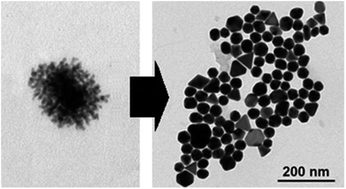The room temperature formation of gold nanoparticles from the reaction of cyclohexanone and auric acid; a transition from dendritic particles to compact shapes and nanoplates†
Abstract
A new straightforward method for the synthesis of

* Corresponding authors
a
Department of Chemistry, University College London, 20 Gordon Street, London, UK
E-mail:
i.p.parkin@ucl.ac.uk
Fax: +44 (0)20 7679 7463
b Department of Chemistry, Imperial College London, South Kensington Campus, London SW7 2AZ, UK
A new straightforward method for the synthesis of

 Please wait while we load your content...
Something went wrong. Try again?
Please wait while we load your content...
Something went wrong. Try again?
M. A. Uppal, A. Kafizas, M. B. Ewing and I. P. Parkin, J. Mater. Chem. A, 2013, 1, 7351 DOI: 10.1039/C3TA11546A
This article is licensed under a Creative Commons Attribution 3.0 Unported Licence. You can use material from this article in other publications without requesting further permissions from the RSC, provided that the correct acknowledgement is given.
Read more about how to correctly acknowledge RSC content.
 Fetching data from CrossRef.
Fetching data from CrossRef.
This may take some time to load.
Loading related content
